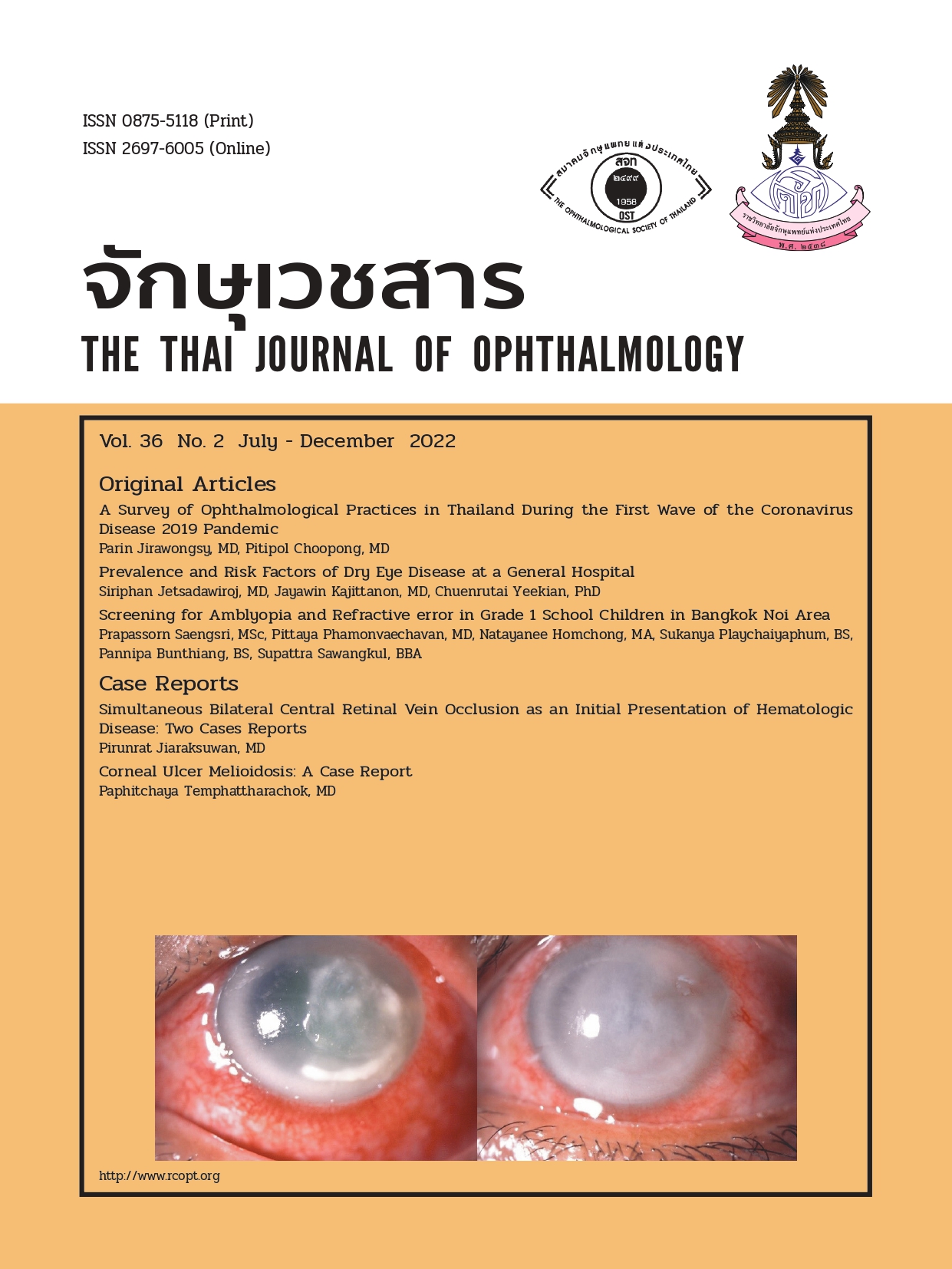การตรวจคัดกรองภาวะตาขี้เกียจและวัดสายตาประกอบแว่นเด็กนักเรียนชั้นประถมศึกษาปีที่ 1 ในโรงเรียนพื้นที่เขตบางกอกน้อย
คำสำคัญ:
ภาวะตาขี้เกียจ, ภาวะสายตาผิดปกติ, ความหนาของชั้นเส้นใยประสาทตาและความหนาของจอตาชั้นปมประสาทตาบทคัดย่อ
วัตถุประสงค์: เพื่อศึกษาอัตราความชุกของภาวะตาขี้เกียจและโรคตาที่พบบ่อย ได้แก่ ภาวะสายตาผิดปกติ, ตาบอดสี, ตาเหล่ รวมถึงความโค้งของกระจกตา, ระดับการมองเห็น, ค่าปกติของความหนาชั้นเส้นใยประสาทตาและของจอตาชั้นปมประสาทตา ในเด็กนักเรียนประถมศึกษาปีที่ 1 โรงเรียนพื้นที่เขตบางกอกน้อย
วิธีการศึกษา: เป็นการศึกษาเชิงตัดขวางในเด็กนักเรียน 15 โรงเรียน ในปี 2561 โดยตรวจคัดกรองตามเกณฑ์มาตรฐานที่กำหนด ได้แก่ วัดสายตา, การมองเห็นสี, วัดค่าสายตาด้วยคอมพิวเตอร์, วัดค่าความโค้งของกระจกตาด้วยเครื่องมือ Autorefractor, ลองแว่นตา, ตรวจภาวะตาเหล่ด้วยวิธีปิดตาสลับข้างร่วมกับปริซึม, วัดความหนาของชั้นเส้นใยประสาทตา และของจอตาชั้นปมประสาทตาด้วยเครื่องมือ Optical coherence tomography
ผลการศึกษา: เด็กนักเรียนที่เข้ารับการตรวจ 386 คน พบมีอัตราความชุกของภาวะตาขี้เกียจ 63 คน โดยพบสาเหตุจากภาวะตาเหล่ 4 คน และภาวะสายตาผิดปกติ 59 คน, ความชุกของภาวะสายตาผิดปกติ 61 คน, ความชุกของภาวะตาเหล่ 13 คน และความชุกของตาบอดสี 14 คน, ค่าเฉลี่ยระดับการมองเห็น ตาขวา 6/9(3/60-6/6) และตาซ้าย 6/9(5/60-6/6), ค่าเฉลี่ยความโค้งของกระจกตา ตาขวา 43.8±1.4(39.0-47.5D) และตาซ้าย 43.8±1.4(38.8-47.8D), ค่าเฉลี่ยความหนาของชั้นเส้นใยประสาทตา ตาขวา 103.6±9.5(67-130µm) และตาซ้าย 102.9±9.1(63-127µm) และค่าเฉลี่ยความหนาของจอตาชั้นปมประสาทตา ตาขวา 86.9±5.1(73-103µm) และตาซ้าย 86.4±5.2(71-104µm)
สรุป: อัตราความชุกภาวะตาขี้เกียจของเด็กนักเรียนประถมศึกษาปีที่ 1 เขตบางกอกน้อย อยู่ในระดับปานกลาง โดยพบภาวะตาขี้เกียจและสายตาผิดปกติเป็นอันดับต้น ส่วนค่าความโค้งของกระจกตา, ความหนาของชั้นเส้นใยประสาทตาและความหนาจอตาชั้นปมประสาทตา มีค่าใกล้เคียงกับค่าปกติในผู้ใหญ่
เอกสารอ้างอิง
โครงการเด็กไทยสายตาดี เพื่อเพิ่มโอกาสการเรียนรู้ ตามนโยบาย ลดเวลาเรียน เพิ่มเวลารู้ปีงบประมาณ. กระทรวงสาธารณสุข. 2559-2560 (Vision2020, the right to sight: WHO) เข้าถึงได้จากhttp://www.mhso.moph.go.th/mhs/attachments/article/691/1.
หทัยชนก ศรีไพโรจน์, ศักดิ์ชัย วงศกิตติรักษ์. ศึกษาความชุกภาวะ ตาบอดสีแดงเขียวในกลุ่มประชากรเด็กวัยเรียน โรงเรียนวัดคุณหญิงส้มจีน จังหวัดปทุมธานี. วารสารจักษุธรรมศาสตร์. 2555; 7(1):7-12.
ศุภา คงแสงไชย. การพัฒนาระบบเฝ้าระวังปัญหาสายตาของนักเรียนในสถานศึกษาขั้นพื้นฐานที่มีมาตรฐานในเชิงคลินิก. วารสารวิชาการบัณฑิตวิทยาลัยสวนดุสิต. 2553; 6 (2):311-24.
สุจินตนา ตันฑเทอดธรรม, ณัชพัณณ์ ปฐมพิทักษ์นุกูล. อัตราความชุกภาวะตาขี้เกียจในเด็กชั้นประถมศึกษาปีที่ 1 จังหวัดนครปฐม. วารสารแพทย์เขต 4-5. 2560; 36(1):13-8.
เมธี จรัสอรุณฉาย, ณัฐนันท์ สกุลสิริทิวากร, วัฒนีย์ เย็นจิต. ตาเหล่และตาขี้เกียจในประเทศไทย. เอกสารประกอบการประชุมวิชาการระดับชาติมหาวิทยาลัยรังสิต. ปทุมธานี: มหาวิทยาลัยรังสิต; 2557.
Drover JR, Kean PG, Courage ML, Adams RJ. Prevalence of amblyopia and other vision disorders in young Newfoundland and Labrador children. Can J Ophthalmol. 2008; 43(1):89-94.
Webber AL, Wood J. Amblyopia: prevalence, natural history, functional effects and treatment. Clin Exp Optom. 2005; 88(6):365-75.
Rajavi Z, Sabbaghi H, Baghini AS, Yaseri M, Moein H, Akbarian S, et al. Prevalence of amblyopia and refractive errors among primary school children. J Ophthalmic Vis Res. 2015; 10(4):408-16.
Woldeamanuel GG, Geta TG. Prevalence of color vision deficiency among school children in Wolkite, Southern Ethiopia. BMC Res Notes (2018) 11:838.
Asbell PA, Chiang B, Somers ME, Morgan KS. Keratometry in children. CLAO J 1990;16(2):99-102.
Demir S, Ozer S, Alim S, Gunes A, Ortak H, Yılmaz R. Retinal nerve fiber layer and ganglion cell-inner plexiform layer thickness in children with obesity. Int J Ophthalmol. 2016; 9(3):434–438.
Harrington S, Breslin K, O'Dwyer V, Saunders K. Comparison of amblyopia in schoolchildren in Ireland and Northern Ireland: a population-based observational cross-sectional analysis of a treatable childhood visual deficit. BMJ Open 2019;9:e031066. doi:10.1136.
Pham Thi Thuy Tien, Nguyen Quang Dai, Trang Thanh Nghiep, Nguyen Tri Dung, Mai Dang Tam. Macular ganglion cell and retinal nerve fiber layer thickness in normal Vietnamese children measured with optical coherence tomography. EyeSEA 2018 ; 13(1) : 1-10.
ดาวน์โหลด
เผยแพร่แล้ว
ฉบับ
ประเภทบทความ
สัญญาอนุญาต
ลิขสิทธิ์ (c) 2023 จักษุเวชสาร

อนุญาตภายใต้เงื่อนไข Creative Commons Attribution-NonCommercial-NoDerivatives 4.0 International License.
The Thai Journal of Ophthalmology (TJO) is a peer-reviewed, scientific journal published biannually for the Royal College of Ophthalmologists of Thailand. The objectives of the journal is to provide up to date scientific knowledge in the field of ophthalmology, provide ophthalmologists with continuing education, promote cooperation, and sharing of opinion among readers.
The copyright of the published article belongs to the Thai Journal of Ophthalmology. However the content, ideas and the opinions in the article are from the author(s). The editorial board does not have to agree with the authors’ ideas and opinions.
The authors or readers may contact the editorial board via email at admin@rcopt.org.


